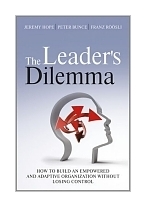|
||
• wydawnictwa polskie
• Zamów informacje o nowościach z wybranego tematu • kontakt
• Cookies na stronie |
THE LEADER'S DILEMMA|: HOW TO BUILD AN EMPOWERED AND ADAPITIVEHOPE J. BUNCE P. ROOSLI F./ ORGANIZATION WITHOUT LOSING CONTROLwydawnictwo: WILEY JOSSEY-BASS , rok wydania 2011, wydanie Icena netto: Many leaders realize that in today's economy it will no longer be the smart highly paid people in the corporate center that drive success. Instead it will come from harnessing the knowledge and creativity of all their people, especially those that work at the interface between the organization and its customers. They also know that their budget-driven management processes are too slow, rigid and expensive and encourage the wrong behaviour. But business leaders are on the horns of a dilemma. How do they empower their people and adapt to change without losing control? This book is about rethinking how we manage organizations in a post-industrial, post credit crunch world where innovative management models represent the only remaining source of sustainable competitive advantage. Above all The Leader's Dilemma is about learning how to change business - based on best practice and innovation drawn from leaders world-wide who have built and managed successful organizations. Table of Contents Foreword. Preface. Some definitions. Introduction. 1 Principle #1 - Values. 2 Principle #2 - Governance. 3 Principle #3 - Transparency. 4 Principle #4 - Teams. 5 Principle #5 - Trust. 6 Principle #6 - Accountability. 7 Principle #7 - Goals. 8 Principle #8 - Rewards. 9 Principle #9 - Planning. 10 Principle #10 - Coordination. 11 Principle #11 - Resources. 12 Principle #12 - Controls. 13 Implementation insights. 14 Make management change your legacy. Notes. Index. 344 pages, Hardcover Księgarnia nie działa. Nie odpowiadamy na pytania i nie realizujemy zamówien. Do odwolania !. |


